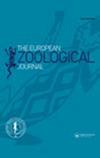First report of live deep-water cnidarian assemblages from the Malta Escarpment
引用次数: 17
Abstract
Abstract A recent geo-marine survey of the Malta Escarpment revealed for the first time the existence of live cnidarian assemblages at about 300 m depth. These associations have been observed by means of a remotely operated vehicle (ROV) during surveys carried out on the upper part of the Malta Escarpment. The assemblages established on hard bedrock were chiefly composed of the antipatharian Leiopathes glaberrima. The Malta Escarpment is known to have been successfully colonised by deep-water scleractinian assemblages until the last glacial age. However, no living specimens had been observed, and only specimens of dead but relatively fresh Dendrophyllia cornigera had been reported. This area of the Mediterranean Sea, which connects the deep Ionian basin to the western Mediterranean, is largely unknown and in clear need of thorough exploration.马耳他悬崖上的活体深水刺胞动物组合的第一份报告
最近对马耳他断崖进行的海洋地质调查首次揭示了300 m深度的活刺胞动物组合的存在。在马耳他悬崖上部进行调查期间,通过远程操作车辆(ROV)观察到这些关联。建立在坚硬基岩上的组合主要由反patharian Leiopathes glaberrima组成。众所周知,直到最后一个冰河时代,马耳他悬崖已经成功地被深水硬石藻组合殖民。然而,没有观察到活的标本,只有死亡但相对新鲜的石斛标本被报道过。地中海的这一区域连接着深爱奥尼亚盆地和西地中海,在很大程度上是未知的,显然需要彻底的探索。
本文章由计算机程序翻译,如有差异,请以英文原文为准。
求助全文
约1分钟内获得全文
求助全文

 求助内容:
求助内容: 应助结果提醒方式:
应助结果提醒方式:


